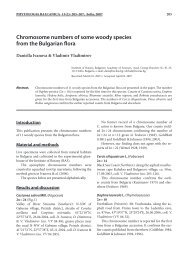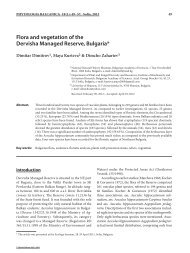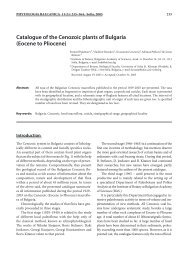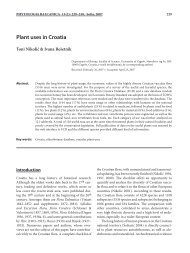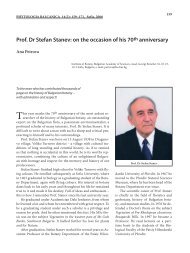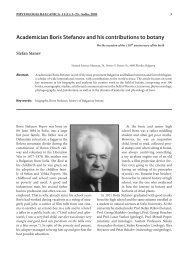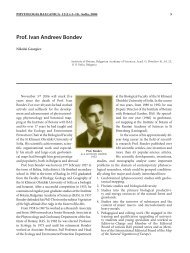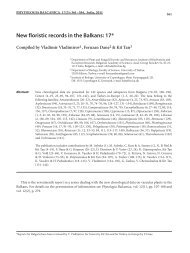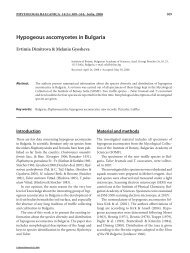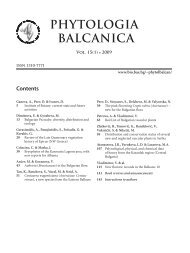14_Atamov, V. & al.indd - Bio.bas.bg
14_Atamov, V. & al.indd - Bio.bas.bg
14_Atamov, V. & al.indd - Bio.bas.bg
Create successful ePaper yourself
Turn your PDF publications into a flip-book with our unique Google optimized e-Paper software.
PHYTOLOGIA BALCANICA 12 (3): 401–412, Sofia, 2006<br />
H<strong>al</strong>ophytication in Harran (Şanlıurfa) and<br />
Amik Plain (Hatay) in Turkey<br />
Vagif <strong>Atamov</strong> 1, Ekrem Aktoklu 2, Esat Cetin 1, Mustafa Aslan 1 & Mahmut Yavuz 1<br />
401<br />
1 Department of <strong>Bio</strong>logy, Faculty of Science and Art, Harran University, Şanlıurfa, Turkey,<br />
e-mail; vhatemov@yahoo.com; vhatemov@harran.edu.tr (corresponding author)<br />
2 Department of <strong>Bio</strong>logy, Faculty of Sciense and Art, Mustafa Kem<strong>al</strong> University, Antakya-<br />
Hatay, Turkey, e-mail: aktoklu@mku.edu.tr<br />
Received: June 20, 2006 ▷ Accepted: September 06, 2006<br />
Abstract. In the studied areas of the Harran and Amik plains some h<strong>al</strong>ophytic species are distributed. The number of these<br />
species in the Harran Plain has started to increase due to improper irrigation after the starting of GAP (Southeast<br />
Anatolian Project). Some of these species distributed in the two plains are: S<strong>al</strong>sola crassa, S. dendroides, S. soda,<br />
Petrosimonia brachiata, Frankenia pulverulenta, Cressa cretica, Chenopodium foliosum, Ch. vulvaria, S<strong>al</strong>icornia<br />
europaea, Aeluropus lagopoides var. lagopoides, Sideritis montana subsp. montana, Hordeum geniculatum, Lolium<br />
subulatum, Cynodon dactylon var. villosus, and Peganum harm<strong>al</strong>a. In the flatlands of Hatay, where soil s<strong>al</strong>inity<br />
is either sm<strong>al</strong>l or medium, the following new associations have been found: Alhago manniferae-Hordetum<br />
murinumae, Prosopo farctae-Hordetum murinumae, Cresso creticae-Hordetum murinumae, Ammio visnagae-<br />
Hordetum murinumae, and in Akçak<strong>al</strong>e: Aeluropuseto lagopoidesae-Chenopodietum vulvariae, Frankenieto<br />
pulverulentae-S<strong>al</strong>soletum sodae and Cresso creticae-Aeluropusetum lagopoidesae. The phytosociologic properties<br />
and productivity of these associations differ from each other and are subject to season<strong>al</strong> changes.<br />
Key words: Amik Plain, association, h<strong>al</strong>ophytication, Harran Plain, phytosociology, Turkey<br />
Introduction<br />
The aim of this study was to investigate the s<strong>al</strong>ine habitats<br />
in the Harran (Şanlıurfa) and Amik plains (Hatay)<br />
and to identify the h<strong>al</strong>ophytic plants. This was carried<br />
out in the period 2000–2005.<br />
In Turkey, pastures cover 28 % of the tot<strong>al</strong> land area<br />
(Anonymous 1978) and 20 % of this area is steadily<br />
destroyed because of inadvertent use and unsuitable<br />
ecologic<strong>al</strong> factors (Genckan & <strong>al</strong>. 1990). Production<br />
of the pastures depends on environment<strong>al</strong> factors and<br />
species composition (Agca 1999). Therefore, botanic<br />
composition has to be elucidated.<br />
The various soil types in the studied area condition the<br />
formation of different associations in the botanic compositions.<br />
The most widespread vegetation types in the region<br />
are the steppe, meadow and water-marsh vegetation.<br />
S<strong>al</strong>inity of soils is an important problem the world<br />
over. Every year the world loses 10 million hectares of<br />
landscape to s<strong>al</strong>inity. Some 1 518 722 ha of land in Turkey<br />
face s<strong>al</strong>inity and <strong>al</strong>k<strong>al</strong>inity problems. This constitutes 2 %<br />
of Turkey’s soil resources. Of these, 6<strong>14</strong> 657 ha have a low<br />
s<strong>al</strong>inity and 504 603 ha have a high s<strong>al</strong>inity level. S<strong>al</strong>inity<br />
is an ever greater problem in the dry or semi-dry climates<br />
due to water evaporation from the lower subsurface<br />
levels (Agca 1999; Akman & <strong>al</strong>. 2001). S<strong>al</strong>ine areas<br />
are increasing in Turkey. In these ecosystems h<strong>al</strong>ophytes<br />
are the dominant species. H<strong>al</strong>ophytes have developed<br />
mechanisms to avoid the stress of s<strong>al</strong>inity through succulency,<br />
s<strong>al</strong>t secretion glands, s<strong>al</strong>t dilution capacity, osmotic<br />
adaptation, protein resistance to high s<strong>al</strong>t concentrations,<br />
and selectivity in absorption through the roots<br />
(Flowers & <strong>al</strong>. 1997a, b; Ungar 1998; Ashraf 1999; Yokoi<br />
& <strong>al</strong>. 2002). H<strong>al</strong>ophytes can grow by accumulating Na +
402 <strong>Atamov</strong>, V. & <strong>al</strong>. • H<strong>al</strong>ophytication in Harran and Amik Plain, Turkey<br />
and Cl – ions, thus creating turgor pressure (Waisel 1972;<br />
Yeo 1983; Guray & Demir 2001).<br />
The Harran Plain is located in Southeast Anatolia, between<br />
36°47´– 39°15´ E and 36°40´– 37°41´ N, and covers<br />
an area of about 225 000 ha bordering on Syria to the<br />
south, Urfa Mts to the north, Fatik Mts to the west, and<br />
Tektek Mts to the east. The Harran Plain and the whole<br />
region have Mediterranean climate, with hot and dry<br />
summers and rainy winters. The average annu<strong>al</strong> rainf<strong>al</strong>l is<br />
30.2 mm, most of which f<strong>al</strong>ls in winter. Topographyc<strong>al</strong>ly,<br />
the plain is a homogenous area, with the surrounding<br />
mountains sloping down to it to form undulating borders.<br />
The Çekçek creek partly changes the homogenity<br />
of its topography (Dinc & <strong>al</strong>. 1988). The soils are <strong>al</strong>luvi<strong>al</strong>,<br />
dark-red or reddish-brown, clayey, moist and c<strong>al</strong>careous.<br />
Earlier in time the plain was dominated by steppe vegetation<br />
but recently it has been transformed into a cultivated<br />
area (Zohary 1973). After the building of the Atatürk<br />
Dam in 1995, s<strong>al</strong>inity has increased in the lower parts of<br />
the plain owing to unwise irrigation and in these areas<br />
the h<strong>al</strong>ophytes now grow and spread out.<br />
Materi<strong>al</strong>s and methods<br />
Some s<strong>al</strong>ine habitats in the Harran Plain (in Gürgelen,<br />
İmambakır and Toytepe villages) were visited twice a<br />
month for one year. Plant specimens were collected<br />
and preserved according to the herbarium techniques.<br />
They were identified with the help of Flora of Turkey<br />
and the East Aegean Islands (Davis 1965–1985; Davis &<br />
<strong>al</strong>. 1988; Güner & <strong>al</strong>. 2000) and other relevant sources<br />
(Akman & <strong>al</strong>. 2001; Cetik 1973), as well as the Floras<br />
of Syria, Iraq and Iran. Regular geobotanic<strong>al</strong> trips were<br />
scheduled to the region and plants were grouped according<br />
to the dominants and edaphic species. Braun-<br />
Blanquet’s method was used for the naming of phytosociologic<br />
plant groups. In the period 1999–2005,<br />
one or two trips were made monthly to Akçak<strong>al</strong>e<br />
(Harran Plain) and the Amik Plain. Research materi<strong>al</strong>s<br />
were taken from the widespread steppe associations of<br />
these regions: Alhago manniferae-Hordetum murinumae<br />
ass. nova, Prosopo farctae-Hordetum murinumae<br />
ass. nova, Ammio visnagae-Hordetum murinumae ass.<br />
nova, Cresso creticae-Hordetum murinumae ass. nova,<br />
Aeluropuseto lagopoidesae-Chenopodietum vulvariae<br />
assoc. nova, Cresso creticae-Aeluropusetum lagopoidesae<br />
assoc. nova, Frankenieto pulverulentae-S<strong>al</strong>soletum<br />
sodae assoc. nova. The amount of phytomass and the<br />
structure of fractions like Hordeum murinum and oth-<br />
er Poaceae, Alhagi mannifera+Prosopis farcta and other<br />
Poaceae, Ammi visnaga+Cressa cretica and other<br />
Poaceae, according to Vagina and Shatochina methods<br />
(Coupland & <strong>al</strong>. 1974; Vagina & Satochina 1976; Sims<br />
& Coupland 1979), applied to pads of 1 m 2 . Phytomass<br />
was studied five times monthly in the associations, as<br />
it was mentioned above (Ilin 1988).<br />
Results and discussion<br />
In the studied area (Akçak<strong>al</strong>e), pH varies between 7.6<br />
and 8.4; the tot<strong>al</strong> s<strong>al</strong>t content is 0.4–1.<strong>14</strong> %; electric conductivity<br />
(EC) registers 4–19.5 dS/m; and the changeable<br />
sodium rate (ESP) is 1.85–39.12 % (Cullu & <strong>al</strong>. 2002).<br />
Şanlıurfa and Hatay cities are situated in a semi-arid<br />
region with Mediterranean climate. In such regions,<br />
the days are hot and arid in summer and rainy in winter.<br />
The amount of rainf<strong>al</strong>l increases in the direction<br />
south-north and west-east (Figs 1, 2, 3a, 3b).<br />
Temparature (C) and Precipitation (mm)<br />
100<br />
90<br />
80<br />
70<br />
60<br />
50<br />
40<br />
30<br />
20<br />
10<br />
0<br />
I II III IV V VI VII VIII IX X XI XII<br />
Months<br />
Temparature<br />
Precipitation<br />
Fig.1. Climatic diagram of Akçak<strong>al</strong>e.<br />
Temparature (C) and Precipitation (mm)<br />
180<br />
170<br />
160<br />
150<br />
<strong>14</strong>0<br />
130<br />
120<br />
110<br />
100<br />
90<br />
80<br />
70<br />
60<br />
50<br />
40<br />
30<br />
20<br />
10<br />
0<br />
I II III IV V VI VII VIII IX X XI XII<br />
Months<br />
Temparature<br />
Precipitation<br />
Fig. 2. Climatic diagram of the Amik Plain.
Phytol. B<strong>al</strong>can. 12(3) • Sofia • 2006<br />
Fig. 3a. Geographic<strong>al</strong> maps in the Akçak<strong>al</strong>e-Syria region<br />
(Şanlıurfa).<br />
Fig. 3b. Geographic<strong>al</strong> maps in the Amik Plain (Hatay).<br />
Table 1. Climate data on the investigated areas.<br />
Station<br />
Akçak<strong>al</strong>e<br />
Antakya<br />
H<br />
(m)<br />
350<br />
85<br />
13 • Phytol. B<strong>al</strong>can. 12(3) • 2006<br />
Meteorologic<strong>al</strong><br />
elements<br />
403<br />
In Akçak<strong>al</strong>e the highest temperature is 40 °C in July,<br />
the lowest is 0.9 °C in February. While the average annu<strong>al</strong><br />
temperature peak is 24.8 °C, the average annu<strong>al</strong> temperature<br />
low is 17.2 °C (Fig. 1). The highest average humidity<br />
is 81.5 % in December and the lowest average<br />
humidity is 39.3 % in June. Average annu<strong>al</strong> humidity<br />
amounts to 62.9 %. The average rainf<strong>al</strong>l reaches its peak<br />
in March (92 mm), f<strong>al</strong>ling down to 0.2 mm in June. No<br />
rain f<strong>al</strong>ls in Akçak<strong>al</strong>e in July and August. Annu<strong>al</strong> rainf<strong>al</strong>l<br />
tot<strong>al</strong>s 363.1 mm (DMI, State Meteorology Office). In the<br />
first part of the year, from November to April, the season<br />
is rainy and humid (i); in the second part, from May<br />
to September, the season is arid (h). The probable frosty<br />
months are (r) from November to March (Fig. 1).<br />
The driest months are July (4.8 mm) and August<br />
(4.6 mm) in Antakya (Hatay). Besides the studies carried<br />
out during these months, precipitation was <strong>al</strong>so registered<br />
in Akçak<strong>al</strong>e. Climatic data on Antakya give the<br />
highest monthly precipitation in December (165.3 mm),<br />
January (158.4 mm), February (155.5 mm), and March<br />
(160.9 mm). Climatic data on the investigated area are<br />
given in a table and a diagram below (Table 1; Figs 1, 2).<br />
The structure of this area differs significantly from<br />
the other parts. This difference is best explained by the<br />
soil an<strong>al</strong>ysis. The soil an<strong>al</strong>ysis from a depth of 0–50 cm<br />
has shown a low humus v<strong>al</strong>ue of 1.01–1.69 % and pH<br />
7.51–7.80 (Table 2). CaCO3 was found to amount to<br />
47–50 %; Ca ++ , Mg ++ to 19.52–22.10 me/100 gr, and<br />
Na + to 2.29–4.31 me/100 gr (the amount of Na + was<br />
increasing with depth).<br />
Chemic<strong>al</strong> content of the soils under the investigated<br />
plant associations are given in Table 3. In the soils under<br />
the associations Cresso creticae-Aeluropusetum lagopoidesae<br />
the tot<strong>al</strong> amount of s<strong>al</strong>t was 0.800 %. In the areas under<br />
the associations Frankenieto pulverulentae-S<strong>al</strong>soletum sodae<br />
and Aeluropuseto lagopoidesae-Chenopodietum vulvariae<br />
the tot<strong>al</strong> amount of s<strong>al</strong>t was double that under the<br />
first associations (between 1.050–1.150 %).<br />
1 2 3 4 5 6<br />
Months<br />
7 8 9 10 11 12 Annu<strong>al</strong><br />
Mean temperature (°C) 6.2 6.4 8.6 13.4 23.5 28.1 31.8 29.1 23.8 18.6 12.7 8.8 17.2<br />
Mean presipitation (mm) 61.6 38.9 92.0 38.9 2.2 0.2 – – 2.3 27.4 36.4 63.2 363.1<br />
Mean temperature (°C) 8.2 9.4 12.6 17.1 21.1 24.5 27.1 27.5 25.4 20.9 13.8 9.6 18.1<br />
Mean presipitation (mm) 158.4 155.5 160.9 87.3 83.2 18.7 4.8 4.6 42.1 68.1 122 165.3 89.2
404 <strong>Atamov</strong>, V. & <strong>al</strong>. • H<strong>al</strong>ophytication in Harran and Amik Plain, Turkey<br />
Table 2. Chemic<strong>al</strong> characteristics of the soil of the Amik Plain.<br />
Associations pH S<strong>al</strong>t<br />
(%)<br />
Steppe vegetation is one of the types found in the<br />
Hatay region. It was composed mainly of the following<br />
plants: Petrosimonia brachiata, S<strong>al</strong>icornia europaea,<br />
Hordeum murinum, Prosopis farcta, and Cressa cretica.<br />
These h<strong>al</strong>ophytic species are widely spread. The<br />
floristic composition, phytosociologic and season<strong>al</strong><br />
features of the region differ from the other steppes.<br />
Hordeum murinum was identified as a widespread<br />
dominant species. In late spring, individu<strong>al</strong>s of this<br />
species turn yellow and begin to wither. This continues<br />
until the end of autumn when the phytocoenoses<br />
completely dry up. In spring, the green plants are<br />
grazed by sheep, goats and cattle, but after withering<br />
Lime<br />
(%)<br />
Changeable Sodium Useful K<strong>al</strong>ium<br />
mg/100gr me/100gr mg/100gr me/100gr<br />
Alhago manniferae-Hordetum murinumae 7.48 0.080 43.3 18.1 0.79 42.1 1.08<br />
Prosopo farctae-Hordetum murinumae 7.59 0.088 41.8 21.3 0.93 34.0 0.87<br />
Ammio visnagae-Hordetum murinumae 7.80 0.056 47.1 11.9 0.52 24.0 0.62<br />
Cresso creticae-Hordetum murinumae 7.59 0.058 50.4 7.9 0.34 29.8 0.76<br />
Table 3. Chemic<strong>al</strong> characteristics of the soil of Akçak<strong>al</strong>e (Harran Plain).<br />
Associations, date and location Tot<strong>al</strong> soil<br />
(%)<br />
Frankenieto pulverulentae-<br />
S<strong>al</strong>soletum sodae<br />
Cresso creticae-<br />
Aeluropusetum lagopoidesae<br />
Aeluropuseto lagopoidesae-<br />
Chenopodietum vulvariae<br />
11.10.2004<br />
Arıcan village<br />
19.04.2005<br />
Altıntepe village<br />
16.03.2005<br />
Syria<br />
19.04.2005<br />
Öncül village<br />
19.10.2004<br />
Öncül village<br />
Saturation<br />
with water (%)<br />
Table 3. Chemic<strong>al</strong> characteristics of the soil of Akçak<strong>al</strong>e (Harran Plain).<br />
Associations, date and location Tot<strong>al</strong> soil<br />
(%)<br />
Frankenieto pulverulentae-<br />
S<strong>al</strong>soletum sodae<br />
Cresso creticae-<br />
Aeluropusetum lagopoidesae<br />
Aeluropuseto lagopoidesae-<br />
Chenopodietum vulvariae<br />
11.10.2004<br />
Arıcan village<br />
19.04.2005<br />
Altıntepe village<br />
16.03.2005<br />
Syria<br />
19.04.2005<br />
Öncül village<br />
19.10.2004<br />
Öncül village<br />
pH CaCO3<br />
(%)<br />
P2O5<br />
(kg/da)<br />
K2O<br />
(kg/da)<br />
Organic mass<br />
(humus) (%)<br />
1.05 55 8.09 10.2 4.9 233.2 1.88<br />
1.05 63 8.27 <strong>14</strong>.0 6.8 183.6 2.03<br />
0.80 72 8.38 13.6 3.4 129.6 3.19<br />
1.15 50 8.45 7.9 0.7 29.1 1.01<br />
1.05 64 8.22 7.2 0.5 58.3 1.74<br />
Saturation<br />
with water (%)<br />
pH CaCO3<br />
(%)<br />
P2O5<br />
(kg/da)<br />
K2O<br />
(kg/da)<br />
Organic mass<br />
(humus) (%)<br />
1.05 55 8.09 10.2 4.9 233.2 1.88<br />
1.05 63 8.27 <strong>14</strong>.0 6.8 183.6 2.03<br />
0.80 72 8.38 13.6 3.4 129.6 3.19<br />
1.15 50 8.45 7.9 0.7 29.1 1.01<br />
1.05 64 8.22 7.2 0.5 58.3 1.74<br />
they become rough and the anim<strong>al</strong>s do not eat them.<br />
This community occasion<strong>al</strong>ly maintains associations<br />
with codominant individu<strong>al</strong>s, such as Cressa cretica<br />
with Cresso creticae-Hordetum murinumae, Alhagi<br />
mannifera with Alhago manniferae-Hordetum murinumae,<br />
Petrosimonia brachiata with Petrosimono brachiatae-Hordeum<br />
murinumae, and Prosopis farcta with<br />
Prosopo farctae-Hordetum murinumae. The phytosociologic<br />
composition and structur<strong>al</strong> features of the<br />
widespread species of this associations are shown in<br />
Tables 6–8.<br />
After irrigation from the Atatürk Dam began<br />
in the period 1995–1999, excessive watering (espe-
Phytol. B<strong>al</strong>can. 12(3) • Sofia • 2006<br />
ci<strong>al</strong>ly for cotton farming) further increased s<strong>al</strong>t levels<br />
in the soil (Cullu & <strong>al</strong>. 2002). Cultivated areas<br />
were occupied by the secondary h<strong>al</strong>ophytes due<br />
to these high s<strong>al</strong>t levels. Out of the 225 000 ha tot<strong>al</strong><br />
area of the Harran Plain, 8513 ha were classified<br />
as highly s<strong>al</strong>ine (Ozkutlu & Ince 1999). Especi<strong>al</strong>ly<br />
in the areas around Akçak<strong>al</strong>e, the tot<strong>al</strong> s<strong>al</strong>inity level<br />
varies between 0.075–1.450 % (Dinc & <strong>al</strong>. 1988).<br />
Topographyc<strong>al</strong>ly, the Harran Plain is lower than its<br />
surroundings and therefore the accumulated water<br />
cannot be drained. The soils of the plain are clayey<br />
and the <strong>bas</strong>e water easily rises to the surface and<br />
evaporates (Ungar 1982; Bertnes & <strong>al</strong>. 1992; Cullu &<br />
<strong>al</strong>. 2002), thus conditioning the s<strong>al</strong>ine areas.<br />
The soil an<strong>al</strong>ysis of the Harran Plain in the period<br />
1987–2000 shows that in 1987, 30 617 ha out of the tot<strong>al</strong><br />
of 36 166 ha had no s<strong>al</strong>inity problems,<br />
but in 2000 that area had shrunk<br />
to 24 674 ha (a drop of 19 %). In 13<br />
years the soils have become s<strong>al</strong>inized<br />
and changed category among the s<strong>al</strong>inized<br />
groups (Figs 4a, 4b; Table 4).<br />
H<strong>al</strong>ophytic areas have been increasing<br />
owing to excessive irrigation<br />
(Figs 4a, 4b, 5). According to soil an<strong>al</strong>ysis,<br />
in the last 13 years (1987–2000)<br />
s<strong>al</strong>ine soils have increased by 394 %<br />
(Cullu & <strong>al</strong>. 2002).<br />
In our study, the following species<br />
were found to dominate in the<br />
area: Prosopis farcta, Alhagi mannifera,<br />
Polygonum arenastrum, P. aviculare,<br />
Rumex pulcher, Chenopodium<br />
<strong>al</strong>bum subsp. <strong>al</strong>bum var. <strong>al</strong>bum,<br />
Peganum harm<strong>al</strong>a, Amaranthus retroflexus,<br />
Cressa cretica, S<strong>al</strong>sola dendroides,<br />
Phragmites austr<strong>al</strong>is, Tamarix<br />
smyrnensis, Glycyrrhiza glabra var.<br />
glabra, and G. glabra var. glandulifera.<br />
Among these, the following species<br />
were secondary over a wide area:<br />
Prosopis farcta, Alhagi mannifera,<br />
Peganum harm<strong>al</strong>a, Phragmites austr<strong>al</strong>is,<br />
Aeluropus lagopoides var. mesopotamica,<br />
and Cynodon dactylon var.<br />
villosus. According to Zohary (1973),<br />
Fig. 4a. Map of s<strong>al</strong>inization for 1990 in the<br />
Harran Plain.<br />
Table 4. S<strong>al</strong>inity levels of the Harran Plain soils (36 166 ha).<br />
S<strong>al</strong>inity level<br />
(ha)<br />
405<br />
there was steppe vegetation in the area. However, under<br />
the impact of ecologic<strong>al</strong> changes imposed by the<br />
anthropogenic factor the vegetation of the region has<br />
undergone a succession<strong>al</strong> change. After 1995, uncontrolled<br />
and excessive watering caused some species,<br />
such as S<strong>al</strong>sola dendroides, Cressa cretica, Phragmites<br />
austr<strong>al</strong>is, etc., migrate into the area, while others,<br />
such as Stipa holosericea, Artemisia herba-<strong>al</strong>ba, A. ab-<br />
Years Difference<br />
from 1987<br />
1987 1990 2000<br />
None s<strong>al</strong>ine 30.617 28.669 24.764 – % 19,2<br />
Slightly s<strong>al</strong>ine 2.788 3.150 4.8<strong>14</strong> + % 72,7<br />
Moderately s<strong>al</strong>ine 2.219 2.219 3.912 + % 76,3<br />
Strongly s<strong>al</strong>ine 542 2.128 2.676 + % 394
406 <strong>Atamov</strong>, V. & <strong>al</strong>. • H<strong>al</strong>ophytication in Harran and Amik Plain, Turkey<br />
Area (%)<br />
90<br />
80<br />
70<br />
60<br />
50<br />
40<br />
30<br />
20<br />
10<br />
0<br />
1987 1990 2000<br />
Year<br />
None s<strong>al</strong>ine<br />
Slightly s<strong>al</strong>ine<br />
Moderately s<strong>al</strong>ine<br />
Strongly s<strong>al</strong>ine<br />
Fig. 5. Variation of<br />
s<strong>al</strong>inity in the Harran<br />
Plain between<br />
1987 and 2000.<br />
Fig. 4b. Map of s<strong>al</strong>inization for 2000 in the<br />
Harran Plain.<br />
sinthium, Festuca c<strong>al</strong>lieri subsp. c<strong>al</strong>lieri,<br />
Poa bulbosa, Teucrium polium,<br />
Astrag<strong>al</strong>us microceph<strong>al</strong>us, Phlomis<br />
pungens var. pungens, Bromus japonicus<br />
subsp. japonicus, Thymbra spicata<br />
var. spicata, Eryngium campestre var. virens,<br />
etc., have left it owing to s<strong>al</strong>inization.<br />
Furthermore, young seedlings of<br />
s<strong>al</strong>inity-tolerant taxa, such as Tamarix<br />
smyrnensis, were detected. Due to anthropogenic<br />
factors, the associations<br />
in the area have been changing to h<strong>al</strong>ophytic<br />
and many adventive species<br />
have emerged, such as Amaranthus retroflexus.,<br />
A. <strong>al</strong>bus, Xanthium strumarium<br />
subsp. strumarium, X. spinosum,<br />
Chenopodium <strong>al</strong>bum subsp. <strong>al</strong>bum<br />
var. <strong>al</strong>bum, Polygonum arenastrum, P.<br />
aviculare, Rumex pulcher, Hyoscyamus<br />
reticulatus, Tribulus terrestris, Urtica<br />
dioica, U. pilulifera, Parietaria judaica,<br />
S<strong>al</strong>sola tragus, Portulaca oleracea,<br />
Heliotropium circinatum, and H. europaeum.<br />
After s<strong>al</strong>inization some plant<br />
species got extinct in the area, while<br />
the habitat of others has shrunk. The<br />
main reason is the increasing s<strong>al</strong>t levels<br />
in the soil. The vegetation cover<br />
in the studied area is about 40–50 %.<br />
Gener<strong>al</strong>ly, this is one-storey vegetation<br />
and the height of the grass is<br />
around 10–20 cm. Only the association<br />
Phragmitetum austr<strong>al</strong>isae reaches<br />
the height of 2 m. This association<br />
grows particularly in or <strong>al</strong>ong the wet<br />
areas and around the irrigation can<strong>al</strong>s<br />
and has a simple structure with domination<br />
of one species (Phragmites<br />
austr<strong>al</strong>is). The following species occasion<strong>al</strong>ly<br />
show presence in the association:<br />
Typha domingensis, T. minima<br />
var. minima, T. minima var. gracilis,<br />
Juncus gerardi subsp. gerardi, J. gerardi<br />
subsp. libanoticus, Carex divisa,<br />
Alopecurus arundinaceus, and A. myosuroides<br />
var. myosuroides. The associa-
Phytol. B<strong>al</strong>can. 12(3) • Sofia • 2006<br />
Table 5. Aeluropuseto lagopoidesae-Chenopodietum vulvariae ass.<br />
nova. Type Relevés no. 23 (In Akçak<strong>al</strong>e-Harran Plain).<br />
Relevés no. 23 24 25 26 27 28 29 30<br />
Wideness of area (m 2 ) 50 50 50 50 50 50 50 50<br />
Altitude (m) 351 350 350 351 350 351 350 350<br />
Inclination (°) 1 2 2 1 2 2 2 2<br />
Length of plant (cm) 40 40 35 45 35 40 40 45<br />
Number of plant (1 m 2 ) 4 5 3 4 4 4 5 3<br />
Plant cover (%) 60 60 40 65 80 40 60 70<br />
Characteristic species of association<br />
Chenopodium vulvaria 13 23 33 33 33 33 23 23 V<br />
Classis of location<br />
Aeluropus lagopoides<br />
var. lagopoides<br />
44 24 24 24 +4 <strong>14</strong> 24 44 V<br />
Tamarix smyrnensis 24 <strong>14</strong> – – – – +4 – II<br />
Factorovskya aschersoniana +1 +1 – – – +1 – – I<br />
Characteristic species of Aeluropion lagopoidesae<br />
Chenopodium foliosum +3 +3 13 13 23 13 +3 +3 V<br />
S<strong>al</strong>sola soda 33 13 13 +3 +3 13 23 13 V<br />
Cressa cretica 12 +2 +2 12 +2 – 12 22 IV<br />
Frankenia pulverulenta – +1 11 +1 – +1 +1 – III<br />
Characteristic species of S<strong>al</strong>solo-Aeluropet<strong>al</strong>ia<br />
Atriplex nitens 13 13 13 – – 13 +3 +3 IV<br />
Polygonum equisetiforme +2 – +2 +2 12 – 12 – III<br />
Gypsophila antari – +1 – +1 – +1 11 11 III<br />
Characteristic species of S<strong>al</strong>icornietea<br />
Peganum harm<strong>al</strong>a 22 +2 22 22 12 12 22 +2 V<br />
Prosopis farcta +2 – +2 +2 – 12 +2 +2 IV<br />
Polygonum aviculare 12 – – 12 12 – +2 – III<br />
Participants<br />
Hymenolobus procumbens 41 31 42 41 41 31 31 31 V<br />
Hordeum murinum<br />
subsp. glaucum<br />
21 11 – 11 +1 – 21 +1 IV<br />
Bupleurum croceum – +1 +1 +1 +1 +1 – +1 IV<br />
Xanthium spinosum +2 – +2 – +2 – +2 +2 III<br />
Hordeum spontaneum – +1 – +1 – – 11 – II<br />
Factorovskya aschersoniana – – – – +1 – +1 – I<br />
Centaurea solstiti<strong>al</strong>is<br />
subsp. solstiti<strong>al</strong>is<br />
Cuscuta p<strong>al</strong>aestina subsp.<br />
b<strong>al</strong>ansae<br />
– – – – – – +1 +1 I<br />
+1 – – – – – +1 – I<br />
407<br />
Table 6. Frankenieto pulverulentae-S<strong>al</strong>soletum sodae ass. nova.<br />
Type Relevés no. 13 (In Akçak<strong>al</strong>e-Harran Plain).<br />
Relevés no. 13 <strong>14</strong> 15 16 17 18 19 20<br />
Classis of location<br />
Wideness of area (m2 ) 50 50 50 50 50 50 50 50<br />
Altitude (m) 350 350 350 350 350 351 350 351<br />
Inclination (°) 1 2 2 1 2 1 2 1<br />
Length of plant (cm) 40 40 45 45 35 40 40 50<br />
Number of plants (1 m2 ) 4 5 3 4 4 4 5 3<br />
Plant cover (%) 65 55 60 40 65 70 50 60<br />
Characteristic species of association<br />
S<strong>al</strong>sola soda 34 34 44 44 34 44 44 44 V<br />
Frankenia pulverulenta 11 – – – – +1 21 21 III<br />
Characteristic species of Aeluropion lagopoidesae<br />
Aeluropus lagopoides<br />
var. lagopoides<br />
<strong>14</strong> 24 <strong>14</strong> 34 24 <strong>14</strong> <strong>14</strong> 34 V<br />
Chenopodium vulvaria 23 13 13 13 33 23 13 +3 V<br />
Cressa cretica 22 +2 22 22 – 32 – 22 IV<br />
S<strong>al</strong>sola incanescens +2 – – – +2 +2 – – II<br />
Characteristic species of S<strong>al</strong>solo-Aeluropet<strong>al</strong>ia<br />
S<strong>al</strong>sola crassa +2 +2 12 12 12 +2 +2 12 V<br />
Polygonum aviculare 22 12 22 12 12 22 12 12 V<br />
Atriplex nitens +3 – 23 13 – – +3 +3 III<br />
Chenopodium sosnowskyi +2 – +2 – +2 +2 – – III<br />
Characteristic species of S<strong>al</strong>icornietea<br />
Peganum harm<strong>al</strong>a 22 22 22 12 22 22 22 +2 V<br />
Polygonum equisetiforme 11 +1 11 11 21 11 +1 +1 V<br />
Alhagi pseud<strong>al</strong>hagi<br />
Participants<br />
+2 +2 12 – – +2 +2 +2 IV<br />
Hymenolobus procumbens 31 41 31 41 31 31 31 31 V<br />
Alhagi mannifera – 33 23 23 23 23 33 33 IV<br />
Xanthium spinosum +1 – +1 – +1 +1 +1 +1 IV<br />
Cuscuta p<strong>al</strong>aestina<br />
subsp. b<strong>al</strong>ansae<br />
– – – +1 +1 – +1 – II<br />
Hypecoum pendulum – – +1 – – +1 +1 – II<br />
Prosopis farcta +1 – +1 – – +1 – – II<br />
Hordeum murinum<br />
subsp. glaucum<br />
+1 +1 – – – – +1 21 II<br />
Centaurea solstiti<strong>al</strong>is<br />
subsp. solstiti<strong>al</strong>is<br />
+1 +1 +1 – +1 – – – II<br />
Ceratoceph<strong>al</strong>us f<strong>al</strong>catus +1 +1 – – +1 +1 – – II<br />
Epilobium hirsutum – – +1 – – – +1 +1 II<br />
Adonis aestiv<strong>al</strong>is<br />
subsp. aestiv<strong>al</strong>is<br />
– +1 +1 +1 – – – – II<br />
Echinaria capitata – –– +1 +1 – – – – I<br />
Factorovskya aschersoniana + – – – – – +1 – I<br />
Oligochaeta divaricata – – – +1 – – +1 – I<br />
Eremopyrum bonaepartis<br />
subsp. bonaepartis<br />
– – – +1 – – +1 – I
408 <strong>Atamov</strong>, V. & <strong>al</strong>. • H<strong>al</strong>ophytication in Harran and Amik Plain, Turkey<br />
Table 7. Cresso creticae-Aeluropusetum lagopoidesae ass. nova.<br />
Type Relevés no. 1 (In Akçak<strong>al</strong>e-Harran Plain).<br />
Relevés no. 1 2 3 4 5 6 7 8 9 10<br />
Wideness of area<br />
(m2 )<br />
50 50 50 50 50 50 50 50 50 50<br />
Altitude (m) 350 349 350 349 349 348 350 350 348 349<br />
Inclination (°) 1 2 2 3 2 1 2 2 2 2<br />
Length of plant (cm) 20 20 25 25 25 20 20 20 25 20<br />
Number of plant<br />
(1 m2 )<br />
4 3 3 4 4 4 2 3 3 3<br />
Plant cover (%) 70 60 70 45 60 60 50 70 70 60<br />
Characteristic species of association<br />
Aeluropus lagopoides 24<br />
var. lagopoides<br />
24 24 24 34 44 34 34 44 34 V<br />
Cressa cretica 22 12 22 – 12 +2 +2 12 12 22 V<br />
Aeluropus littor<strong>al</strong>is <strong>14</strong> – <strong>14</strong> +4 <strong>14</strong> +4 – +4 <strong>14</strong> – IV<br />
Characteristic species of Aeluropion lagopoidesae<br />
S<strong>al</strong>sola soda 13 13 23 23 23 +3 23 23 13 33 V<br />
Gypsophila antari – +1 11 +1 11 11 11 – 11 11 IV<br />
Frankenia<br />
pulverulenta<br />
– +1 11 +1 – – – 21 21 21 III<br />
Petrosimonia<br />
brachiata<br />
+1 – +1 – +1 – – +1 – – II<br />
Chenopodiım <strong>al</strong>bum<br />
subsp. <strong>al</strong>bum<br />
var. <strong>al</strong>bum<br />
– +1 – +1 – – – – +1 – II<br />
Classis of location<br />
Characteristic species of S<strong>al</strong>solo-Aeluropet<strong>al</strong>ia<br />
Polygonum aviculare 12 12 12 12 +2 12 12 22 12 22 V<br />
S<strong>al</strong>sola crassa – +2 +2 +2 +2 – +2 12 12 12 IV<br />
Cynodon dactylon<br />
var. dactylon<br />
33 – +3 – – 13 +3 +3 – – III<br />
Characteristic species of S<strong>al</strong>icornietea<br />
Alhagi mannifera +3 33 43 43 23 13 – – +3 23 IV<br />
S<strong>al</strong>icornia europaea +2 +3 +3 +3 II<br />
Prosopis farcta – – 12 12 12 12 – +2 – – III<br />
Polypogon maritimus +1<br />
subsp. maritimus<br />
Participants<br />
– – +1 – +1 – – +1 – II<br />
Hymenolobus<br />
procumbens<br />
11 11 +1 +1 + +1 11 11 11 +1 III<br />
Factorovskya<br />
aschersoniana<br />
+1 – +1 +1 +1 – + – + +1 II<br />
Phleum exaratum<br />
subsp. exaratum<br />
+1 +1 +1 – 11 – +1 11 – +1 II<br />
Avena eriantha +1 – – +1 – – +1 +1 – +1 II<br />
Centaurea solstiti<strong>al</strong>is<br />
subsp. solstiti<strong>al</strong>is<br />
– +1 – +1 – – +1 – +1 – II<br />
Epilobium hirsutum – +1 +1 – – +1 – – – – II<br />
Ph<strong>al</strong>aris paradoxa – – – – +1 – – – +1 – I<br />
Lathyrus sativus +1 – – – – – +1 – – – I<br />
Ornithog<strong>al</strong>um<br />
umbellatum<br />
– – – – +1 – – – +1 – I<br />
Table 8. Cresso creticae-Hordetum murinumae ass. nova.Type<br />
Relevés no. 34 (In Selam-Amik Plain).<br />
Relevés no. 31 32 33 34 35 36 37 38<br />
Wideness of area (m2 ) 50 50 50 50 50 50 50 50<br />
Altitude (m) 85 83 85 85 85 86 84 85<br />
Inclination (°) 1 2 2 1 2 2 2 2<br />
Length of plant (cm) 35 40 35 45 35 30 30 25<br />
Number of plant (1 m2 ) 4 5 3 4 4 4 5 3<br />
Plant cover (%) 55 50 45 45 65 45 55 70<br />
Classis of location<br />
Characteristic species of association<br />
Hordeum murinum<br />
subsp. glaucum<br />
13 23 33 33 33 33 23 23 V<br />
Cressa cretica 22 24 24 24 +4 11 23 34 V<br />
Alhagi mannifera 24 <strong>14</strong> – – – – +4 – II<br />
Characteristic species of Hordetion murinumae<br />
Chenopodium foliosum +3 +3 13 13 23 13 +3 +3 V<br />
Prosopis farcta 33 13 13 +3 +3 13 23 13 V<br />
Petrosimonia brachiata 12 +2 +2 12 +2 – 12 22 IV<br />
Euphorbia macroclada – +1 11 +1 – +1 +1 – III<br />
Characteristic species of S<strong>al</strong>solo-Aeluropet<strong>al</strong>ia<br />
Atriplex nitens 13 13 13 – – 13 +3 +3 IV<br />
Polygonum equisetiforme +2 – +2 +2 12 – 12 – III<br />
Gypsophila antari – +1 – +1 – +1 11 11 III<br />
Characteristic species of S<strong>al</strong>icornietea<br />
Peganum harm<strong>al</strong>a 22 +2 22 22 12 12 22 +2 V<br />
Adonis annua +2 – +2 +2 – 12 +2 +2 IV<br />
S<strong>al</strong>icornia europaea<br />
Participants<br />
12 – – 12 12 – +2 – III<br />
Geranium dissectum 11 21 +1 21 11 11 – – IV<br />
Raphanus raphanustrum 21 11 – 11 +1 – 21 +1 IV<br />
Ranunculus chius – +1 +1 – +1 +1 – +1 II<br />
Ranunculus cornutus +2 – +2 – +2 – +2 +2 III<br />
Cichorium intybus – +1 – +1 – – 11 – II<br />
Cerastium anom<strong>al</strong>um – – – – +1 – +1 – I<br />
Ornithog<strong>al</strong>um<br />
umbellatum<br />
+1 – – – +1 – – – I<br />
Consolida orient<strong>al</strong>is – – – +1 – – – +1 I<br />
Lactuca serriola – – – – – – +1 – I<br />
Rumex tuberosus<br />
subsp.tuberosus<br />
– – +1 – +1 – – – I<br />
Allium scorodoprasum<br />
subsp. rotundum<br />
– – – – – +1 – – I<br />
Melilotus indica – +1 – +1 – – – +1 I<br />
Cuscuta p<strong>al</strong>aestina<br />
subsp. b<strong>al</strong>ansae<br />
+1 – – – – – +1 – I<br />
Centaurea solstiti<strong>al</strong>is<br />
subsp. solstiti<strong>al</strong>is<br />
– – – – – – +1 +1 I
Phytol. B<strong>al</strong>can. 12(3) • Sofia • 2006<br />
tion Glycyrrhizetum glabrae, dominated by Glycyrrhiza<br />
glabra, is <strong>al</strong>so wide-spread <strong>al</strong>ong the roads and on the<br />
edge of the fields. This association grows in low-level<br />
h<strong>al</strong>ophytic areas, occasion<strong>al</strong>ly mixed with Prosopis<br />
farcta and Alhagi pseudo<strong>al</strong>hagi and may form the associations<br />
Glycyrrhizeto glabra-Prosopetum farctae and<br />
Glycyrrhizeto glabra-Alhagetum pseudo<strong>al</strong>hagae. The<br />
number of these associations increases with the level<br />
of s<strong>al</strong>t in the soil, as well as that of G. glabra.<br />
Classification of vegetation in the investigated area:<br />
Type: H<strong>al</strong>ophytic steppe<br />
Classis: S<strong>al</strong>icornietea<br />
Ordo: S<strong>al</strong>solo-Aeluropet<strong>al</strong>ia<br />
Alliance: Aeluropion lagopoidesae<br />
Associations:<br />
Aeluropuseto lagopoidesae – Chenopodietum vulvariae<br />
ass. nova<br />
Frankenieto pulverulentae – S<strong>al</strong>soletum sodae ass. nova<br />
Cresso creticae – Aeluropusetum lagopoidesae ass.<br />
nova<br />
Alliance: Hordetion murinumae<br />
Associations:<br />
Prosopo farctae – Hordetum murinumae ass. nova<br />
Cresso creticae – Hordetum murinumae ass. nova<br />
Alhago manniferae – Hordetum murinumae ass. nova<br />
Ammio visnagae – Hordetum murinumae ass. nova<br />
Type: Meadow and water-marsh<br />
Classis: Phragmitetea<br />
Ordo: Phragmitet<strong>al</strong>ia<br />
Alliance: Phragmition austr<strong>al</strong>isae<br />
Association: Phragmitetum austr<strong>al</strong>isae<br />
A list of widespread plant associations in the area<br />
is given in Table 5–10 and a vegetation map of the<br />
investigated area is given in. After spring, very few<br />
plant species with a short vegetation period survive<br />
until autumn. Most h<strong>al</strong>ophytic species are as follows:<br />
Cressa cretica, Alhagi mannifera, Petrosimonia brachiata,<br />
S<strong>al</strong>icornia europaea, and Ammi visnaga.<br />
The high summer temperatures cause floor water<br />
to sink to lower layers. Therefore, plants with roots<br />
that can reach these lower levels can survive as phytosenoses.<br />
With the autumn rains, seeds which have<br />
f<strong>al</strong>len between soil layers during summer germinate<br />
and grow into new green plants. Consequently, the<br />
soil surface turns completely green in February. The<br />
young shoots, which have emerged during these peri-<br />
409<br />
ods, reach 5–6 cm in height at the end of May. When<br />
ephemerous plants mature, most of them bloom and<br />
develop seeds at the beginning of June, and shed these<br />
seeds in July and August. The seeds of Petrosimonia<br />
brachiata, however, mature and are shed in early autumn.<br />
In season<strong>al</strong> dynamics, the herbaceous association<br />
Hordetum murinumae (formed by dominating<br />
Hordeum murinum) is one of the most widespread<br />
associations in the investigated area (Table 11). The<br />
dry-matter output of the association in its steppe habitats<br />
changes according to season. This variability is<br />
at its minimum in early spring and at its maximum in<br />
autumn. In winter, it decreases again and minimizes<br />
(Table 11). The role of geophytes in phytomass formation<br />
is important. However, in summer and autumn<br />
the role of perenni<strong>al</strong> plants is important too. In spring,<br />
grasses (Poaceae) <strong>al</strong>so form a signiifcant part of the<br />
phytomass.<br />
In summer and autumn, the herbs output depends<br />
on the development of ephemerous plants and the v<strong>al</strong>ues<br />
change between 122.5–411.0 gr/m 2 . On the contrary,<br />
in winter it amounts to 10.1–21.5gr/m 2 and<br />
there is a clear downslide. Season<strong>al</strong> changes in phytomass<br />
depend on the amount of different groups, such<br />
as fodder crops in the region.<br />
Three important agrobotanic<strong>al</strong> groups of Hordeum<br />
murinum and other Poaceae, participating in<br />
the composition of the plant groups, exist in each<br />
group. Their amount changes according to the associations<br />
(Table 12). This variability can be observed<br />
in the amount of each agrobotanic<strong>al</strong> group. While<br />
Hordeum murinum and other Poaceae and Alhagi<br />
mannifera+Prosopis farcta and other Poaceae can<br />
be observed mainly in spring, other herbs prevail<br />
in summer and autumn. This depends on the various<br />
perenni<strong>al</strong> plants and the long vegetation periods.<br />
These results play an important role in the phytomass<br />
structure in autumn. Among various herbs, the most<br />
widespread dominant species is Ammi visnaga, which<br />
is not eaten by anim<strong>al</strong>s because of the essenti<strong>al</strong> oil in<br />
its composition. When it is dominant, it suppresses<br />
the other plants because of its height of over 1 m. This<br />
species spreads out as a secondary plant flora in the<br />
region.<br />
The productivity of the widespread plant associations<br />
in the studied area is illustrated in Table 13.<br />
The productivity of dry herbs varies between 310–<br />
1200 gr/m 2 (Table 13).
410 <strong>Atamov</strong>, V. & <strong>al</strong>. • H<strong>al</strong>ophytication in Harran and Amik Plain, Turkey<br />
Table 9. Ammio visnagae-Hordetum murinumae ass. nova.<br />
Type Relevés no. 45 (In Selam-Amik Plain)<br />
Rrelevés no. 39 40 41 42 43 44 45 46<br />
Classis of location<br />
Wideness of area (m2 ) 50 50 50 50 50 50 50 50<br />
Altitude (m) 82 85 85 85 85 86 84 85<br />
Inclination (°) 1 2 1 1 2 1 2 1<br />
Length of plant (cm) 60 55 65 45 75 70 65 55<br />
Number of plant (1 m2 ) 4 5 6 4 7 4 5 5<br />
Plant cover (%) 65 65 60 55 65 70 55 60<br />
Characteristic species of Ammi visnagae-Hordetum murinumae<br />
Ammi visnaga 34 34 44 44 34 44 44 44 V<br />
Hordeum murinum<br />
subsp. glaucum<br />
44 33 23 33 44 44 45 33 V<br />
Aegilops biunci<strong>al</strong>is – +2 +1 +1 – – 11 +1 II<br />
Avena sterilis<br />
subsp. ludoviciana<br />
+1 +2 – – +1 +1 +2 +2 III<br />
Lolium rigidum var. rigidum – – +1 +1 +2 +2 – +1 II<br />
Characteristic species of Hordetion murinumae<br />
Alhagi mannifera <strong>14</strong> 24 <strong>14</strong> 34 24 <strong>14</strong> <strong>14</strong> 34 V<br />
Chenopodium vulvaria 23 13 13 13 33 23 13 +3 V<br />
Cressa cretica 22 +2 22 22 – 32 – 22 IV<br />
Petrosimonia brachiata +2 – +2 – +2 +2 – – II<br />
Hordeum bulbosum 11 – – 11 – +1 21 21 III<br />
Characteristic species of S<strong>al</strong>solo-Aeluropet<strong>al</strong>ia<br />
Euphorbia macroclada +2 +2 12 12 12 +2 +2 12 V<br />
Polygonum aviculare 11 12 11 – 12 – 12 +2 V<br />
Atriplex nitens +3 – 23 13 – – +3 +3 III<br />
Cirsium lappaceum +2 – +2 – – +2 – – III<br />
Characteristic species of S<strong>al</strong>icornietea<br />
Aegilops biunci<strong>al</strong>is 22 22 22 12 22 22 22 +2 IV<br />
Bromus tectorum 11 +1 11 11 21 11 +1 +1 III<br />
Eremopoa capillaris +2 +2 12 – – +2 +2 +2 II<br />
S<strong>al</strong>icornia europaea<br />
Participants<br />
+2 – – – +2 +1 – – I<br />
Anthemis tinctoria<br />
var. tinctoria<br />
31 21 11 21 31 31 31 31 IV<br />
Aegilops biunci<strong>al</strong>is – 33 23 23 23 23 33 33 IV<br />
Xanthium spinosum +1 – +1 – +1 +1 +1 +1 III<br />
Cuscuta p<strong>al</strong>aestina<br />
subsp. b<strong>al</strong>ansae<br />
– – – +1 +1 – +1 – II<br />
Hypecoum pendulum – – +1 – – +1 +1 – II<br />
Crypsis aculeata +1 – +1 – – +1 – – II<br />
Lagurus ovatus +1 +1 – – – – +1 21 II<br />
Centaurea solstiti<strong>al</strong>is<br />
subsp. solstiti<strong>al</strong>is<br />
+1 +1 +1 – +1 – – – II<br />
Ceratoceph<strong>al</strong>us f<strong>al</strong>catus +1 +1 – – +1 +1 – – II<br />
Epilobium hirsutum – – +1 – – – +1 +1 II<br />
Adonis aestiv<strong>al</strong>is subsp.<br />
aestiv<strong>al</strong>is<br />
– +1 +1 +1 – – – – II<br />
Echinaria capitata – –– +1 +1 – – – – I<br />
Oligochaeta divaricata – – – +1 – – +1 – I<br />
Eremopyrum bonaepartis<br />
subsp. bonaepartis<br />
+1 – – – – – +1 – I<br />
Table 10. Prosopo farctae-Hordetum murinumae ass. nova.<br />
Type Relevés no. 54 (In Selam-Amik Plain).<br />
Relevés no. 47 48 49 50 51 52 53 54 55 56<br />
Wideness of area<br />
(m2 )<br />
50 50 50 50 50 50 50 50 50 50<br />
Altitude (m) 85 85 84 85 85 86 84 85 83 86<br />
Inclination (°) 1 2 2 3 2 1 2 2 2 2<br />
Length of plant (cm) 20 20 25 25 25 20 20 20 25 20<br />
Number of plant<br />
(1 m2 )<br />
5 3 4 5 4 6 2 3 4 5<br />
Plant cover (%) 50 65 75 55 60 65 50 65 70 60<br />
Characteristic species of Prosopo farctae-Hordetum murinumae<br />
Hordeum murinum<br />
subsp. glaucum<br />
24 34 24 24 34 44 34 34 44 34 V<br />
Prosopis farcta 22 +2 22 – 12 +2 +2 22 12 22 V<br />
Avena sterilis<br />
subsp. ludoviciana<br />
12 – 11 +4 12 +4 – +4 12 – IV<br />
Characteristic species of Alhago manniferae-Hordetum murinumae<br />
Alhagi mannifera 13 13 23 23 23 +3 23 23 13 33 V<br />
Characteristic species of Hordetion murinumae<br />
Chenopodiım <strong>al</strong>bum – +1 11 +1 11 11 11 – 11 11 IV<br />
Hordeum bulbosum – +1 11 +1 – – – 21 21 21 III<br />
Petrosimonia<br />
brachiata<br />
+1 – +1 – +1 – – +1 – – II<br />
Melilotus indica – +1 – +1 – – – – +1 – II<br />
Characteristic species of S<strong>al</strong>solo-Aeluropet<strong>al</strong>ia<br />
Polygonum aviculare 12 12 12 12 +2 12 12 22 12 22 V<br />
Euphorbia f<strong>al</strong>cata – +2 +2 +2 +2 – +2 12 12 12 IV<br />
Cynodon dactylon<br />
var. dactylon<br />
33 – +3 – – 13 +3 +3 – – III<br />
Characteristic species of S<strong>al</strong>icornietea<br />
Alhagi mannifera +3 33 43 43 23 13 – – +3 23 IV<br />
Petrosimonia<br />
brachiata<br />
+2 +3 +3 +3 II<br />
Aegilops biunci<strong>al</strong>is – – 12 12 12 12 – +2 – – III<br />
Polypogon maritimus +1<br />
subsp. maritimus<br />
– – +1 – +1 – – +1 – II<br />
S<strong>al</strong>icornia europaea<br />
Participants<br />
+2 – – – +2 – – – I<br />
Bromus japonicus<br />
subsp. japonicus<br />
41 31 31 41 31 41 41 31 31 31 V<br />
Lagurus ovatus 11 – – 11 11 – – 11 +1 11 IV<br />
Phleum exaratum<br />
subsp. exaratum<br />
+1 +1 +1 – 11 – +1 – +1 III<br />
Avena eriantha +1 – – +1 – – +1 +1 – +1 III<br />
Centaurea solstiti<strong>al</strong>is<br />
subsp. solstiti<strong>al</strong>is<br />
– +1 – +1 – – +1 – +1 – II<br />
Epilobium hirsutum – +1 +1 – – +1 – – – – II<br />
Ph<strong>al</strong>aris paradoxa – – – – +1 – – – +1 – I<br />
Crypsis aculeata – 11 – – – – +1 – – I<br />
Classis of location
Phytol. B<strong>al</strong>can. 12(3) • Sofia • 2006<br />
Table 11. Season<strong>al</strong> dynamic of the associations (Amik Plain, during 1999–2000).<br />
Associations<br />
Output (gr/m2 Spring<br />
) and seasons<br />
Summer Autumn Winter<br />
Alhago manniferae-Hordetum murinumae <strong>14</strong>6.0 182.0 281.4 12.4<br />
Prosopo farctae-Hordetum murinumae 213.0 195.2 263.7 –<br />
Ammio visnagae-Hordetum murinumae 122.5 413.0 411.0 21.5<br />
Cresso creticae-Hordetum murinumae 104.1 120.1 238.7 15.7<br />
Table 12. The structure of above-ground phytomass in the associations according to agrobotanic<strong>al</strong> groups (Amik Plain).<br />
Associations Tot<strong>al</strong> gr/m2 Fractions (gr/m2 Hordeum murinum<br />
)<br />
Alhagi mannifera+Prosopsis Ammi visnaga+Cressa<br />
and other Poaceae farcta and other Poaceae cretica and other Poaceae<br />
Alhago manniferae-Hordetum murinumae 413.0 120.0 17.7 276.2<br />
Prosopo farctae-Hordetum murinumae 195.7 105.7 90.0 –<br />
Ammio visnagae-Hordetum murinumae 106.9 60.9 – 46.0<br />
Cresso creticae-Hordetum murinumae 229.0 79.0 – 150.0<br />
Table 13. Productivity of prev<strong>al</strong>ent plants in the studied area (Akçak<strong>al</strong>e).<br />
Species Fresh weight (gr/m 2 ) Dry weight (gr/m2) Rate of damp (%)<br />
Aeluropus lagapoides var. lagapoides 1620 1200 25.9<br />
S<strong>al</strong>sola soda 2050 860 58.1<br />
Cressa cretica 670 290 56.7<br />
Alhagi mannifera 1<strong>14</strong>0 310 72.8<br />
Average 1370 665 53.3<br />
Conclucions<br />
1. H<strong>al</strong>ophytic areas in the Harran plain were studied<br />
in the following districts: Gürgelen, Toytepe and<br />
İmambakır villages, places at <strong>al</strong>titude of 330–350 m<br />
in Akçak<strong>al</strong>e county towards the border with Syria.<br />
2. In this region, h<strong>al</strong>ophytic areas have increased<br />
steadily due to irrigation. These h<strong>al</strong>ophytic areas<br />
have increased by 394 % from 1987 to 2000.<br />
3. The following species grow in the areas (Harran<br />
and Amik): Prosopis farcta, Alhagi pseudo<strong>al</strong>hagi,<br />
A. mannifera, Polygonum arenastrum, Xanthium<br />
spinosum, X. strumarium, Chenopodium <strong>al</strong>bum,<br />
Rumex pulcher, Peganum harm<strong>al</strong>a, Amaranthus<br />
retroflexus, A. <strong>al</strong>bus, Cressa cretica, Petrosimonia<br />
brachiata, S<strong>al</strong>icornia europaea, S<strong>al</strong>sola soda, S. dendroides,<br />
Frankenia pulverilenta, Phragmites austr<strong>al</strong>is,<br />
Tamarix smyrnensis, Glycyrrhiza glabra var. glabra,<br />
G. glabra var. glandulifera, Aeluropus lagopoides<br />
var. lagopoides, A. littor<strong>al</strong>is, Cynodon dactylon.<br />
4. Due to increasing s<strong>al</strong>inization, the following species<br />
have migrated into the areas: S<strong>al</strong>sola dendroides,<br />
Cressa cretica, Tamarix smyrnensis.<br />
<strong>14</strong> • Phytol. B<strong>al</strong>can. 12(3) • 2006<br />
411<br />
5. Due to anthropogenic factors, the vegetation has<br />
changed to a succession containing h<strong>al</strong>ophytic<br />
plants, such as Amaranthus retroflexus, A. <strong>al</strong>bus,<br />
Xanthium strumarium, X. spinosum, Chenopodium<br />
<strong>al</strong>bum subsp. <strong>al</strong>bum var. <strong>al</strong>bum, Polygonum arenastrum,<br />
P. aviculare, Rumex pulcher, Hyoscyamus reticulatus,<br />
Tribulus terrestris, Urtica dioica, U. pilulifera,<br />
Parietaria judaica, Phys<strong>al</strong>is <strong>al</strong>kekengi, S<strong>al</strong>sola<br />
tragus, Portulaca oleracea, Heliotropium circinatum,<br />
H. europaeum.<br />
6. Vegetation of the investigated Harran and Amik<br />
plains has been classified, and two types, two classes,<br />
two orders, three <strong>al</strong>liances, and eight associations<br />
have been determined.<br />
References<br />
Agca, N. 1999. Soil s<strong>al</strong>inity and fodder – GAP. Fodder Congress,<br />
26–28 May 1999, Şanlıurfa, no. 2, pp. 915-922 (in Turkish).<br />
Akman, Y., Ketenoğlu, O. & Geven, F. 2001. Vegetation Ecology<br />
and Methods. Ankara Univ. Press., Ankara (in Turkish).<br />
Anonymous. 1978. The existing land acreage in Turkey. Soilwater<br />
Gener<strong>al</strong> Dept., Soil and Mapping Dept., Ankara (in Turkish).<br />
Ashraf, M. 1999. Breeding for s<strong>al</strong>inity tolerance proteins in<br />
plants. – Crit. Rev. Pl. Sci., 13: 17-42.
412 <strong>Atamov</strong>, V. & <strong>al</strong>. • H<strong>al</strong>ophytication in Harran and Amik Plain, Turkey<br />
Bertness, M.D., Gough, L. & Shumvay, S.W. 1992. S<strong>al</strong>t tolerances<br />
and distribution of fugitive s<strong>al</strong>t marsh plants. – Ecology, 73:<br />
1842-1851.<br />
Cetik, R. 1973. Vegetation Science. Ankara Univ. Press, Ankara<br />
(in Turkish).<br />
Coupland, R.T., Abouguendia, Z. & Producars, V. 1974. Dynamics<br />
of shoot development in grasses and sedges. – Matador Project<br />
Technic<strong>al</strong> Report. no. 51. Saskatoon.<br />
Cullu, M.A., Almaca, A., Şahin, Y. & Aydemir, S. 2002. Application<br />
of GİS monitoring soil s<strong>al</strong>inization in the Harran Plain. – İnt.<br />
Conf. Sustainable Land Use and Management, Canakk<strong>al</strong>e. Pp.<br />
326-33.<br />
Davis, P.H. (ed.). 1965–1985. Flora of Turkey and the East Aegean<br />
Islands. Vols 1-9. Edinburgh Univ. Press, Edinburgh.<br />
Davis, P.H., Mill, R.R. & Kit Tan (eds). 1988. Flora of Turkey<br />
and the East Aegean Islands. Vol. 10. Edinburgh Univ. Press,<br />
Edinburgh.<br />
Dinc, U., Şenol, S., Sayın, M., Kapur, S., Güzel, N., Derici, R.,<br />
Yeşilsoy, M.Ş., Yeğingil, İ., Sarı, M., Kaya, Z., Aydın, M. &<br />
Kettaş, F. 1988. Soils in the Northwestern Anatolia Regions<br />
(GAP 1. Harran Plain, TÜBİTAK Fodder and Forest Search<br />
Groups. Conclusion Rep.. Project no. TOAG-534).<br />
Flowers, T.J., Troke, P.F. & Yeo, A.R. 1997a. The mechanism<br />
of s<strong>al</strong>t tolerance in h<strong>al</strong>ophytes. – Annu<strong>al</strong> Rev. Pl. Physiol., 28:<br />
89-121.<br />
Flowers, T.J., Troke, P.F. & Yeo, A.R. 1997b. Breeding for s<strong>al</strong>t<br />
tolerance in crop plants – the role of molecular biology. – Acta<br />
Physiol. Pl., 19: 427-733.<br />
Genckan, M.S., Avcıoglu, R.S. & Dogan, O.O. 1990. Problems and<br />
decisions. Utilization, conservation and devolepment of Turkish<br />
pastures. – Third Turkish Agricultur<strong>al</strong> Engineering Congress,<br />
8–12 January. Pp. 53-61.<br />
Güner, A., Özhatay, N., Ekim, T. & Başer, K.H.C. (eds.) 2000.<br />
Flora of Turkey and the East Aegean Islands. Vol. 11. Edinburgh<br />
Univ. Press, Edinburgh.<br />
Guray, H. G. & Demir, M. 2001. The changes in contents of s<strong>al</strong>t<br />
marsh species and the importance of edaphic physicochemic<strong>al</strong><br />
factors. – Arab Gulf J. Sci. Res., 19: 35-43.<br />
Ilin, V.B. (ed.). 1988. <strong>Bio</strong>logic<strong>al</strong> Productivity of Grassland<br />
Ecosystems. Nauka, Novosibirsk (in Russian).<br />
Ozkutlu, F. & Ince, F. 1999. Offici<strong>al</strong> s<strong>al</strong>inity statistics and possible<br />
widespread area in the Harran Plain. – GAP 1 Fodder Congress,<br />
26–28 May 1999, Sanlıurfa. No. 2, pp. 909-9<strong>14</strong>.<br />
Sims, P.L. & Coupland, R.T. 1979. Producers. – In: Coupland,<br />
R.T. (ed.). Grassland Ecosystems of the World. Vol. 8, pp. 49-72.<br />
Cambridge Univ. Press, Cambridge.<br />
Ungar, I.A. 1982. Germination ecology of h<strong>al</strong>ophytes. – In: Sen,<br />
D.N. & Rajpurohit, K.S. (eds), Tasks for Vegetation Science.<br />
Vol. 2. Junk Publishers.<br />
Ungar, I.A. 1998. Are biotic factors significant in influencing the distribution<br />
of h<strong>al</strong>ophytes in s<strong>al</strong>ine habitats? – Bot. Rev., 64: 176-199.<br />
Vagina, T.A. & Satochina, N.G. 1976. Dynamic Accumulation of<br />
Above – Ground and Underground Organic Mass in the Steppe,<br />
Meadow and Water-Marshs Phytocenoses. Nauka, Novosibirsk<br />
(in Russian).<br />
Waisel, Y. 1972. <strong>Bio</strong>logy of H<strong>al</strong>ophytes. Acad. Press, New York,<br />
London.<br />
Yeo, A.R. 1983. S<strong>al</strong>inity resistance: Physiologies and prices. –<br />
Physiol. Plant., 58: 2<strong>14</strong>-220.<br />
Yokoi, S., Bressan, R.A. & Hasegawa, P.M. 2002. S<strong>al</strong>t stress tolerance<br />
of plants. –JIRCAS Working Report. Pp. 25-33.<br />
Zohary, M. 1973. Geobotanic<strong>al</strong> Foundations of the Middle East.<br />
Vol. 2, pp. 473-500. Stuttgart.



